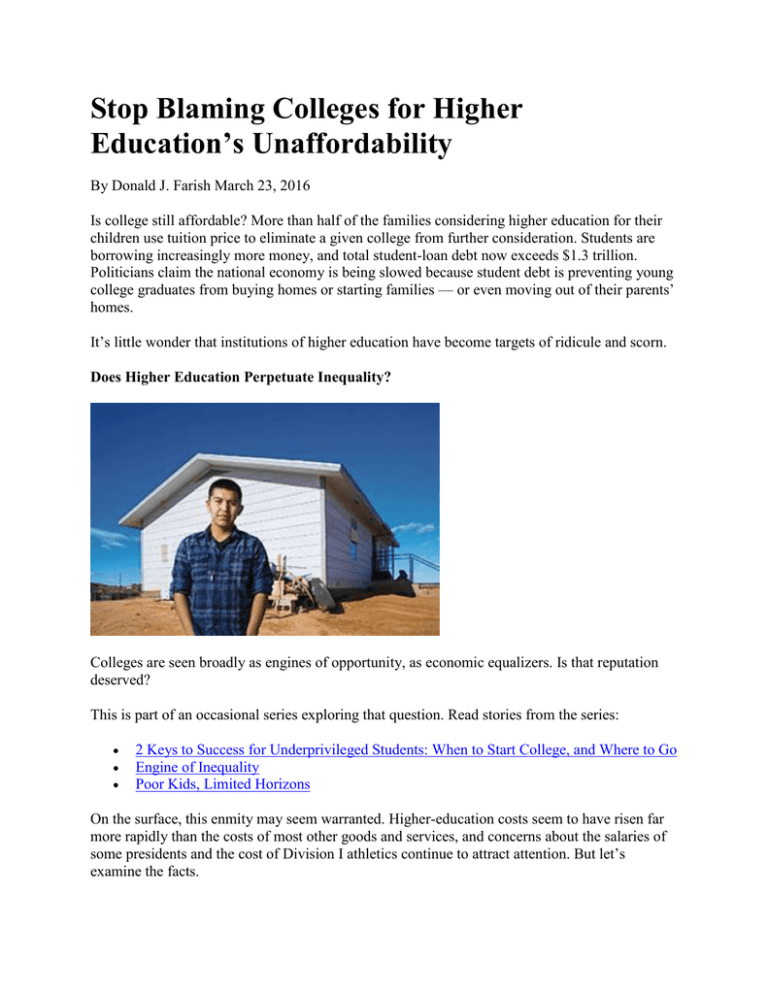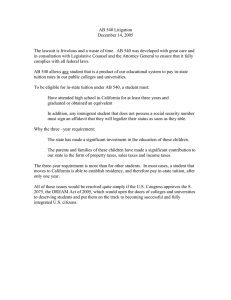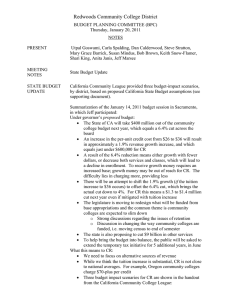Stop Blaming Colleges for Higher Education’s Unaffordability
advertisement

Stop Blaming Colleges for Higher Education’s Unaffordability By Donald J. Farish March 23, 2016 Is college still affordable? More than half of the families considering higher education for their children use tuition price to eliminate a given college from further consideration. Students are borrowing increasingly more money, and total student-loan debt now exceeds $1.3 trillion. Politicians claim the national economy is being slowed because student debt is preventing young college graduates from buying homes or starting families — or even moving out of their parents’ homes. It’s little wonder that institutions of higher education have become targets of ridicule and scorn. Does Higher Education Perpetuate Inequality? Colleges are seen broadly as engines of opportunity, as economic equalizers. Is that reputation deserved? This is part of an occasional series exploring that question. Read stories from the series: 2 Keys to Success for Underprivileged Students: When to Start College, and Where to Go Engine of Inequality Poor Kids, Limited Horizons On the surface, this enmity may seem warranted. Higher-education costs seem to have risen far more rapidly than the costs of most other goods and services, and concerns about the salaries of some presidents and the cost of Division I athletics continue to attract attention. But let’s examine the facts. At four-year public institutions, the average list price for tuition and fees has risen 114 percent, to $9,410, in inflation-adjusted dollars over the past 20 years. But the average net price has risen by just 48 percent over the same time, to $3,980. A long and steepening decline in state financial support of public colleges is responsible for most of the tuition increase. As measured by dollars of appropriation per $1,000 of income, state appropriations to public colleges and universities fell by 43 percent from 1990 to 2015. The average list price for private-college tuition and fees rose by 70 percent over the past 20 years, to $32,405. But the average net price rose by just 32 percent over the same years to $14,890, and at most private colleges prices actually declined between 2008 and 2013. (The university where I work, for example, froze tuition in 2012, and hasn’t increased it since.) Families turned off by high prices never learn how much they would have really paid, because they never applied in the first place. So, because of significant increases in institutional financial aid, the actual increase in the cost of tuition and fees has been less than half the increase in the published price of tuition and fees — but families turned off by high prices never learn how much they would have really paid, because they never applied in the first place. The affordability of any product or service is partly a function of its price, and partly a function of the relative affluence of the consumer. So can today’s families afford college? In inflationadjusted dollars, between 1984 and 2014, those in the top 5 percent of family income saw their average income increase by 79 percent, to an average of $370,085. Families in the middle 20 percent of income witnessed an increase of 16 percent, to $66,899. But families in the bottom 20 percent of income experienced a 1 percent drop in average income, to just $16,110. And all of the growth in income was between 1984 and 2004. During the past decade, almost all families saw their inflation-adjusted incomes either stagnate or shrink. For example, families in the top 5 percent on average saw no growth in income; the middle-income families saw a 2percent decline; and families in the bottom percentile experienced a 9-percent decline. Thus, although the 20-year increases in net tuition and fees at public and private colleges were most likely not a problem for families in the top 5 percent of income, those increases were a real challenge for families in the middle 20 percent, and were devastating to families in the bottom 20 percent. It is understandable then, on the basis of cost alone, why the percentage of high-school graduates from the lowest 20 percent who enroll in college fell from 56 percent in 2008 to less than 46 percent in 2013. There is no question that higher-education leaders have a responsibility to make their institutions affordable for students from all income levels. As a group, we have been too slow to acknowledge that responsibility, and to respond accordingly. To be fair, however, it is only in the last few years that we have seen significant price resistance to our costs (some very rich and famous institutions have yet to see price resistance), and, in our capitalist system, one tends to charge as much as one can get for a particular product or service. Yet a significant part of college affordability rests not with the colleges themselves, but with an economic structure that, in the absence of policy to the contrary, defaults to a situation where a handful of individuals amass a majority of the wealth. This is what has occurred at an increasing rate in the United States since the 1950s, and the concentration of wealth at the top of the economic spectrum is now seen by many economists as an enormous problem: Productivity has increased in virtually every part of the economy, but wages have not come close to keeping pace. More and more families are finding it increasingly difficult to make ends meet, because their incomes have not risen alongside increases in the cost of living. Big-ticket items such as a college education seem increasingly unaffordable — because they are. Yet political leaders appear intent on ignoring the elephant in the room. It is far easier for them to cast blame on colleges than it is to advocate for changes in economic policies that cater to the wealthy, and punish the poor and working class. Dealing with the growing income and wealth inequality in this country is the job of state and national political leaders, and it is up to us to ensure that they accept that burden, rather than shoving all of the responsibility for college affordability back on us. Donald J. Farish is president of Roger Williams University.


